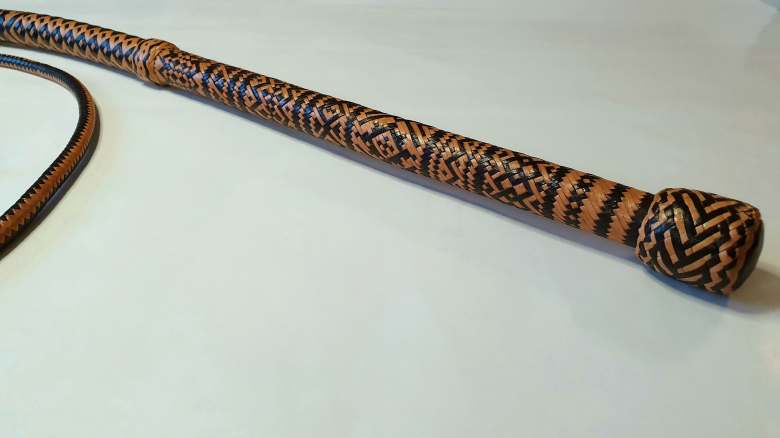With the first three decisions made, you have essentially finished picking out your your first whip! Congratulations! Depending on what you’ve decided on, your maker may have a few other questions for you. These are arguably less important than the first three, so don’t worry about them too much. We will cover a few of them below, but don’t be afraid to ask your whip maker if you are unsure. Oftentimes, they know best.
Plait/Plait Count


A whip’s plait or plait count is the number of strands the whip maker will put in the whip’s overlay. This is typically more relevant with leather whips, but nylon whips may vary in plait count as well. A whip’s plait count can vary anywhere from 4 (very basic) to 64 (very intricate!), or even higher. As a rule of thumb, any plait above 8 can be enough for a high-functioning leather whip. and 12 – 24 is a good amount for nylon.
Handle Length

Handle length is a common thing to consider when ordering a whip. Generally, the longer a handle is, the easier it will be to manoeuvre the whip around your body. However, if the whip is very heavy or long, a long handle can make it much harder to operate the whip comfortably.
If you are unsure, you should ask for your maker’s recommendation or choose a medium length for a good all-purpose whip. Bullwhip handles are typically 6” – 14”, stockwhip handles are typically 16” – 24”, and PH whip handles are typically 14” – 20”.
Fall Length
This is the length of the fall on your whip. The fall is the long strip attached to the thong that has the cracker tied on to the end. Opinions typically vary on this subject: some whip makers think that the fall length should be one standard length, some think that the fall length should vary relative to the length of the whip, and others think that it doesn’t matter at all. Falls are often replaced after a lot of use because they take the majority of the strain that is caused by the whip moving at supersonic speeds. In general, your whip maker should know the ideal fall length that they are making you, so ask them.
Shot-Loaded or Not Shot-Loaded
A whip is shot-loaded/lead-loaded if the maker has put steel BB’s or another type of weight in the whip’s core in order to make the whip heavier. In the past, heavier whips were favoured rather than lighter ones because they felt easier to crack. On the other hand, lighter whips move through the air faster than heavier ones, and are easier to volley. For these reasons, shot-loading your whip depends entirely on personal preference. In general, assume your maker knows best.
Colour
While this question is typically more relevant for nylon whips because of paracord’s multiple colours, leather can also be dyed different colours to suit the whip cracker’s needs. Obviously, colour makes no real difference in how the whip operates, but it can make a difference for performers and others who want their whip to be seen.
Bright colours like white are generally considered the easiest to be seen in person and on video in any environment. Unfortunately, these whips are also often susceptible to grass stains and otherwise getting dirty, so be prepared to clean them once in a while if you want them to look nice. Meanwhile, dark colours like black or brown are more common for people who want a conventional “whip” look. It is also possible to get whips in multiple colours and plaiting patterns if your maker has the materials and experience necessary. It’s really up to you!

